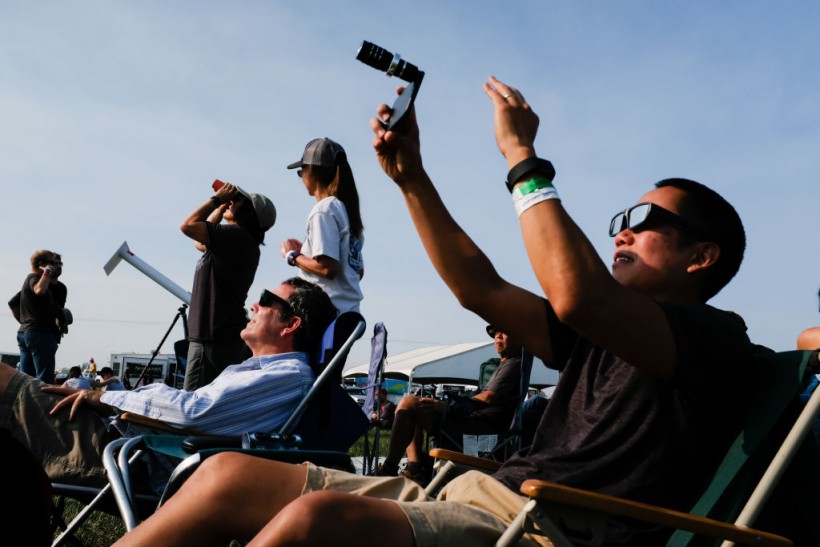The upcoming total solar eclipse on April 8 won't repeat for another two decades. According to NASA, this extraordinary event will be larger in diameter than the last total solar eclipse in 2017 with the Moon positioned closer to Earth.
It will be visible across all 48 contiguous states with specific regions spanning from Texas to Maine experiencing full totality. But is it safe to capture the event using a smartphone? Learn how best and safely do that in this article.

(Photo : ROB KERR/AFP via Getty Images)
Smartphone Safety Tips for Eclipse Viewing
Prevent Blindness, an organization committed to eye health and safety, advises against smartphone usage during the eclipse due to potential dangers. They caution against the risk of accidentally viewing the sun while using a smartphone camera, which may also pose harm to the device.
This advice specifically pertains to the partial phases of the eclipse, visible to those outside the path of totality. Attempting to photograph a partial solar eclipse with a smartphone may result in overexposure due to the remaining uneclipsed sun.
To capture an image of the partial solar eclipse safely, experts recommend using filters similar to those found in solar eclipse glasses. Dr. Ralph Chou, an optometry professor, suggests cutting eclipse glasses in half and taping one piece over the smartphone camera lens.
Alternatively, ready-made smartphone solar filters are available for purchase, such as the VisiSolar Smartphone Photo Filter and the Solar Snap Eclipse App Kit. These filters, along with clip-on zoom lenses, can enhance the quality of eclipse photos taken with smartphones.
If you are in the path of totality, you will also witness the partial phases of the eclipse before the sun's face is completely blocked by the moon. During this brief period of totality, it is safe to remove eye and smartphone filters to view the spectacle directly.
For capturing photos and videos during totality, experts recommend specific techniques such as turning off the flash, using ultrawide mode, and composing shots with the eclipsed sun centrally. Setting up a smartphone on a tripod beforehand enables stable recording and allows for capturing personal reactions during totality.
READ ALSO: What To Expect During Totality? Here's a Guide to the April 8 Solar Eclipse Across North America
Guidelines and Indirect Observation Methods for April 8 Solar Eclipse
Staring directly at the sun, especially during an eclipse, poses serious risks to your vision. Even without immediate discomfort, you could suffer from solar retinopathy, resulting in eye pain, blind spots, and blurred vision.
To safely view the eclipse, you need approved solar eclipse glasses meeting ISO 12312-2 standards, as regular sunglasses aren't sufficient. These glasses limit luminous and wavelength transmittance, including UVA, UVB, and infrared rays.
Many recommended vendors offer these glasses, such as Warby Parker, Staples, Lowes, and Walmart, or online through B&H and various science and astronomy stores. Be cautious of purchasing from unknown sellers on Amazon or eBay to avoid getting counterfeit glasses.
Alternatively, you can observe the eclipse indirectly by creating a pinhole viewer or using objects with perforated holes to project multiple eclipse images. Building a simple box projector is another option for a clearer view.
Never look at the eclipse through binoculars or a telescope directly; instead, use them to project the image onto a surface like paper for safe viewing.
RELATED ARTICLE: Total Solar Eclipse 2024: A Guide to the Path of Totality, its Mechanics, and Prime Viewing Locations
Check out more news and information on Solar Eclipse in Science Times.














